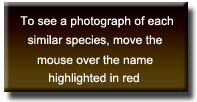
 |
|
|
Leucania lapidaria has the same approximate range as Leucania multilinea. Leucania lapidaria is slightly smaller and the hind wing is all white without the brown suffusion of the margin found in multilinea. If mixed series of the two species are collected from the same locality, they can usually be sorted by the difference in size and the hindwing. However isolated specimens can be difficult to identify without dissection of the male genitalia. The vesica of the male genitalia (the evertible portion of the aedeagous) of lapidaria has a single large spine on a separate diverticulum in addition to the row of smaller spines found in both species. This spine is absent in multilinea.
Leucaia phragmatidicola is a smoother appearing species and lacks a dark, slanting stripe from the base of the forewing inner margin. The range of multilinea overlaps that of Leucania multilinea in western Alberta. However anteroclera also lacks the dark slanting streak from the forewing lower margin near the base.
The white line from the base of the wing to the discal dot is not as heavily shaded with black below as in multilinea and in addition anteroclera lacks a slanting line from the inner margin of the forewing
Leucania commoides is somewhat similar to both multilinea and lapidaria, but is darker and the hindwing is completely suffused with dark gray-brown. Leucania multilinea Walker Diagnosis: A species of the northern United States and southern Canada. Forewing light straw-brown. Wing with a striate appearance. A white line running from the base of the wing to the discal dot, this white line accented below with dark brown. Discal dot a small, black spot. A dark brown line slants outward from the lower wing margin (inner margin) from near the base of the wing. Hindwing white, but with the outer margin suffused with dirty brown. Distribution (See map below): This species occurs throughout the nothern United States and southern Canada from Nova Scotia in the east to western Alberta in the west. The species extends southward as far as Illinois in the west to New York City in the east. Identification Quality: Excellent Habitat: This species occurs in northern deciduous forest and in the transitional zone. However no information is available on specific habitats. Foodplants: Bromus sp., Agropyron repens, Dactylis glomerata (all Poaceae)* (Godfrey, 1972, U.S. Department of Agriculture Technical Bulletin, 1450: 91.) * lab reared, possibly not a natural foodplant. Larval Description: Godfrey, 1972, U.S. Department of Agriculture Technical Bulletin, 1450: 91, figs. 224, 476. |
Leucania multilinea
Similar Species: Leucania lapidaria Leucania phragmatidicola Leucania anteroclera Leucania commoides
|
Similar Species |
 |
